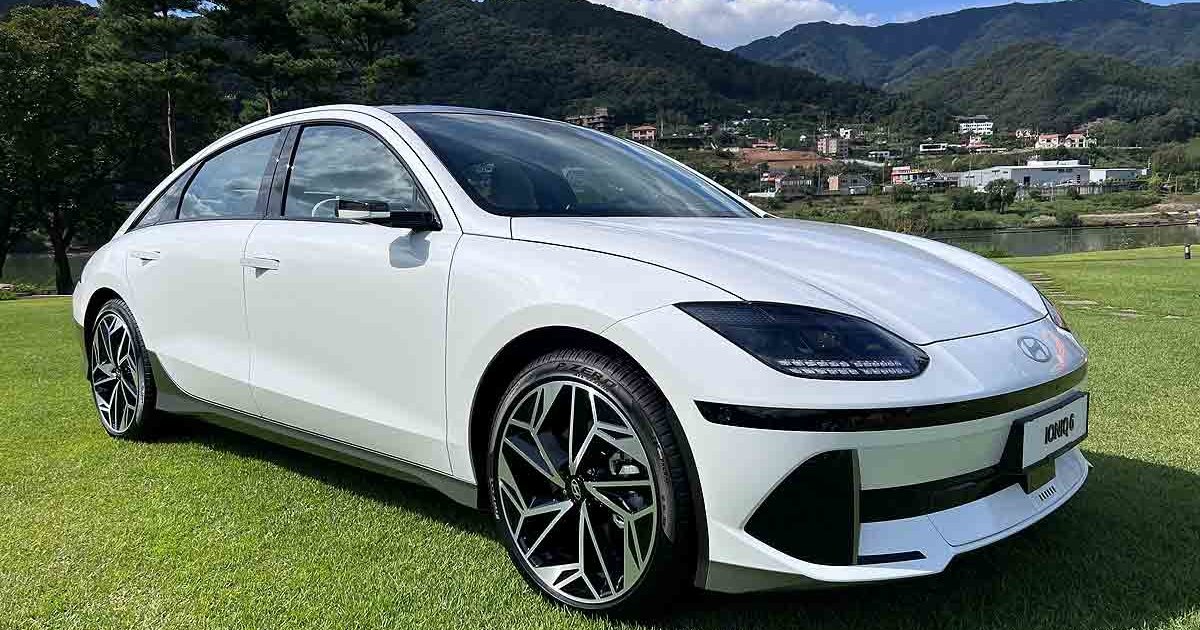
SEOUL — Just how slippery is Hyundai’s new Ioniq 6 electric vehicle?
When the four-door fastback sedan arrives in the U.S. early next year, it will have the same platform and long-range powertrain as the Ioniq 5 compact crossover. But the Ioniq 6 will get a big boost in battery range — thanks mostly to its super sleek, air-shedding silhouette.
In fact, the Ioniq 6 is the most aerodynamic vehicle ever produced by Hyundai Motor Co. It achieves a 0.21 drag coefficient, compared with 0.29 for the Ioniq 5, which landed this year.
Hyundai is loath to label the Ioniq 6 a mere sedan. To its designers, the jelly bean-shaped EV is a “streamliner,” a name that harks back to the rounded styles pioneered in the 1930s.
The rear-wheel-drive version with the 77.4-kilowatt-hour battery achieves a range of 381 miles under the Worldwide Harmonized Light Vehicles Test Procedure cycle. That’s a jump from the 315-mile range of the Ioniq 5.
The Ioniq 6’s pinched-off boat-tail aerodynamics are absolutely key to its eking out more miles.
“The most improvement resulted from a decrease in air resistance,” Hyundai global design chief Simon Loasby said of the Ioniq 6 at a late September drive event here.
“It takes our customer farther on a single charge.”
Loasby challenged his team to deliver a drag coefficient below 0.20 by printing a T-shirt emblazoned with “0.1x.” They didn’t quite get there. But the Ioniq 6’s coefficient still lands in the realm of such heavy hitters as the Porsche Taycan, Tesla Model 3 and Lucid Air.
“Everyone said, ‘You’re mad. You’ll never hit that target,’ ” Loasby said. “I know, but I wanted to see how far we can get. And that was our sort of mentality for the project.”
The Ioniq 6 doesn’t have an EPA-rated range yet. But Hyundai expects it to be around 330 miles, about 9 percent higher than the Ioniq 5’s 303 miles. The Ioniq 6’s U.S.-rated range should be finalized before the car’s North American debut at the Los Angeles Auto Show in November.
The car has already gone on sale in South Korea, where Hyundai says it has more than 40,000 preorders, and lands in Europe this year. It enters production for North America in January at Hyundai’s Asan plant in South Korea, with deliveries landing stateside two or three months later. At Asan, the Ioniq 6 is made on the same line as the Hyundai Sonata sedan.
The Ioniq 6 is the second in the carmaker’s new Ioniq subline of EVs, all of which are built on Hyundai Motor Group’s E-GMP platform, which is shared with Kia Corp.
After the Ioniq 5 and Ioniq 6 will come the Ioniq 7, a three-row crossover due in 2024 or 2025. Loasby said many of the aero enhancements of the Ioniq 6 will be deployed in the Ioniq 7. As a bigger, boxier vehicle, the Ioniq 7 will need every last design trick to extend its charge.
No tweak was too small to give the Ioniq 6 better aerodynamics. Hyundai said it spent more than 5,000 hours simulating different adjustments on supercomputers.
Pop-out door handles, full-body undercover, aero wheels, winglets along the rear fender and a low beltline in the front all help shed more air. Active air flaps along the front lip open only when necessary to cool the battery; otherwise, they stay shut to channel air to the sides.
A large rear spoiler — reminiscent of a vintage Porsche 911 ducktail — adds to the package, also with a bit of flare. The top is inlaid with a deck of pixelated plastic that lights up during braking.
Hyundai even flattened the brand’s “H” emblem on the hood to speed airflow.
Another innovation are the gap closers in the front wheel wells. Because of the Ioniq 6’s short front overhang, wind didn’t stream so smoothly around the front at first. To better guide the air, designers added small strips that narrow the gap between the fender and tires.
The Ioniq 6 also adopts digital side cameras instead of traditional glass and metal mirrors. They beam images to small video screens on the right and left of the dashboard.
The small profile of the external cameras pushes less air than clunky mirrors. Hyundai estimates they add about a mile of range. American drivers, however, won’t be able to tap this technology, as video side mirrors have yet to win regulatory approval in the U.S.
Finally, specially designed low-rolling resistance tires further extend the car’s range.
After an all-day 132-mile drive on the expressways of Seoul and on the country highways outside the capital city, the Ioniq 6 test car finished with 56 percent of its battery charge intact and a range of 141 miles still on the meter.
The Ioniq 6 is a key step in Hyundai’s EV transformation plan. The company wants to sell 1.87 million battery-electrics a year by 2030 by introducing 17 new EV models — 11 for the Hyundai brand and six for the Genesis premium marque. To get there, CEO Jaehoon Chang said in March his company will invest $13.48 billion in electrification.